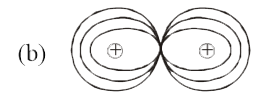Which of the following figure shows the correct equipotential surfaces of a system of two positive charges?
A

B

C

D

Video Solution
|
Answer
Step by step video & image solution for Which of the following figure shows the correct equipotential surfaces of a system of two positive charges? by Physics experts to help you in doubts & scoring excellent marks in Class 11 exams.
Updated on:21/07/2023
Topper's Solved these Questions
Similar Questions
Knowledge Check
- Question 1 - Select One
Which of the following is correct regarding equipotential surface ?
AEquipotential surfaces can never cross each other otherwise potential at a point will have two values which is absurdBEquitential surfaces are always perpendicular to lines of forceCIf a charge is moved from one point to the other over an equipotential surface, work done will be zero as
WAB=−UAB=Q(VB−VA=0(as(VB=VA)DAll options are correct - Question 2 - Select One
Which of the following statements is incorrect regarding equipotential surfaces ?
AEquipotential surfaces are closer in regions of large electric fields compared to regions of lower electric fields.BEquipotential surfaces will be more crowded near sharp edges of a conductor.CEquipotential surface will be more crowded near regions of large charge densitiesDequipotential surfaces will always be equally spaced. - Question 3 - Select One
The shape of equipotential surfaces due to an isolated charge is
AConcentric spherical shells and the distance between the shells increases with the decrease in electric fieldBConcentric spherical shells and the distance between the shells decreases with the decrease in electric fieldCEqui-spaced concentric spherical shellsDChanges with the polarity of the charge
Draw equipotential surfaces for a single point charge O>0.
View SolutionWhat is the shape of equipotential surface for a given point charge q.
View SolutionCan two equipotential surfaces cut each other?
View SolutionIf the given figure shows equipotential surfaces, then the magnitude of electric field is
 View Solution
View SolutionIn the following figure, equipotential lines are shown
 View Solution
View Solution

